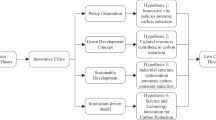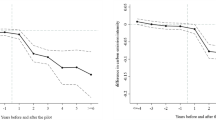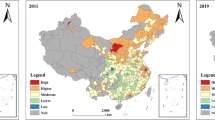Abstract
The intelligent city pilot policy is a major measure in China to promote urban development from factor driven and investment driven to innovation driven. Intelligent city construction can effectively coordinate specialized production factors and information sharing mechanism, promote digital information technology innovation, promote smart industry cluster, and expand ecological scenarios of clean industry application, so as to reduce carbon emissions. This paper reveals the internal mechanism of intelligent city construction to promote carbon emission reduction. Based on the quasi-natural experiments carried out in three batches of pilot construction of intelligent cities since 2012, the difference-in-difference model (DID) is used to identify its impact on urban carbon emissions. The research results show that the pilot construction of intelligent cities is conducive to reducing carbon emissions, which is still robust under multiple scenarios such as placebo test and endogenous test. Heterogeneity analysis shows that the pilot policies have a more significant carbon emission reduction effect on the Beijing-Tianjin-Hebei urban agglomeration, non-resource-based cities, and non-old industrial bases. After further quantitative analysis of 917 pilot policy texts based on Simhash algorithm, Jieba word segmentation, and word frequency statistics, it is found that intelligent industry policies reduce carbon emissions by driving data elements agglomeration and optimizing industrial structure, while intelligent government and intelligent people’s livelihood policies improve energy efficiency and reduce carbon emissions through green technological innovation. Counterfactual tests using machine learning algorithms show that the later the pilot batch, the better the sustainable carbon emission reduction effect of intelligent city pilot policies.

Similar content being viewed by others
Data availability
The data that support the findings of this study are openly available on request.
Notes
Including per capita GDP, per capita area of paved roads, total investment in fixed assets, actual foreign investment, total population at the end of the year, number of public trams per 10,000 people, green coverage in built-up areas, number of people employed in scientific research, technology and service industries, the proportion of tertiary industry output in GDP, etc.
References
Bagayev I, Lochard J (2017) EU air pollution regulation: a breath of fresh air for Eastern European polluting industries? J Environ Econ Manag 83:145–163
Chao XJ, Xue ZX, Sun YM (2020) The impact of new digital infrastructure on the upgrading of foreign trade: empirical evidence from Chinese cities at prefecture level and above. Econ Sci 3:46–59
Chen ZJ, Fan QW (2020) ‘Sacrificed Parts’: the logic and consequences of pollution transfer. Yunnan Soc Sci 4:144–151+179
Condliffe S, Ashton MO (2009) The effects of air quality regulations on the location decisions of pollution-intensive manufacturing plants. J Regul Econ 36(1):83–93
Copeland BR, Taylor MS (2004) Trade, growth, and the environment. J Econ Lit 42(1):7–71
Cui LZ, Chen QY (2019) Research on the environmental effect of intelligent city incremental expansion policy. Shanghai Econ Res 4:62–74
Dong L, Liu LJ (2015) Clustering trend of producer services in the process of intelligent city. Sci Technol Manag Res 35(12):123–127
Doytch N, Uctum M (2016) Globalization and the environmental im-pact of sectoral FDI. Econ Syst 40(4):582–594
Du JG, Wang Y, Zhao AW (2020) Research on the influence and mechanism of intelligent city construction on urban green development. Soft Sci 34(9):59–64
Ferrara R (2015) The intelligent city and the green economy in Europe: a critical approach. Energies 8(6):4724–4734
Glaeser EL, Lu M (2018) Human-capital externalities in China. NBER Working Paper 24925
Han F, Xie R (2017) Does agglomeration of producer services reduce carbon emissions: spatial econometric analysis of panel data of prefecture-level and above cities in China. J Quant Tech Econ 34(3):40–58
Hong YX (2017) Analysis of the stage of technological innovation and its innovation value chain. De Economist 4:5–12
Ikefuji M, Itaya JI, Okamura M (2016) Optimal emission tax with endogenous location choice of duopolistic firms. Environ Resource Econ 65(2):463–485
Jiang MH, Wu YJ (2015) Spatial agglomeration, spatial correlation and intelligent city growth: a spatial metrology study based on Chinese intelligent city pilot. Sci Technol Manag Res 35(18):172–178
Jin XY (2018) Environmental regulation and domestic pollution transfer: based on the ‘11th Five-Year Plan’ COD discharge control plan investigation. Ind Econ Res 6:115–125
Jin H, Li RJ, Li YY (2017) Investment in science and technology finance, development of high-tech industry and optimization of industrial structure: an empirical study based on provincial panel data PVAR model. Indus Technol Econ 36(7):42–48
Li PX, Cao YH (2013) The spatial-temporal pattern evolution of regional industrial carbon emissions in the context of industrial transfer: a case study of Pan-Yangtze River Delta. Adv Earth Sci 28(8):939–947
Li ZG, Wang J (2021a) The spatial emission reduction effect of carbon emission trading in China: a quasi-natural experiment and policy spillover. China Popul Resour Environ 31(1):26–36
Li ZG, Wang J (2021b) The development of digital economy, data element allocation and manufacturing productivity improvement. De Economist 10:41–50
Lin MS (2016) Carbon emission reduction during urbanization in China: economic costs and mitigation strategies. Quant Tech Econ Res 33(3):59–77
Liu Z (2014) Human capital externalities in cities: evidence from Chinese manufacturing firms. J Econ Geogr 14(3):621–649
Liu B, Dong ZQ (2020) Does the energy bias of technological progress induce ‘carbon lock-in effect’? J Obstet Econ 11(4):133–148
Macke J, Casagrande RM, Sarate JAR (2018) Smart city and quality of life: citizens' perception in a Brazilian case study. J Clean Produc 182: 717–726
Martin C, Evans J, Karvonen A et al (2019) Intelligent-sustainability: a new urban fix? Sustain Cities Soc 45:640–648
Nicolas C, Kim J, Chi S (2021) Natural language processing-based characterization of top-down communication in intelligent cities for enhancing citizen alignment. Sustain Cities Soc 66:102674
Shen KR, Jin G, Xian F (2017) Does environmental regulation cause pollution to be transferred nearby? J Econ Res 52(5):44–59
Shi D, Li SL (2020) Emission trading system and energy use efficiency: an empirical study of cities at prefecture level and above. Chin Indus Econ 9:5–23
Shi DQ, Ding H, Wei P et al (2018) Can intelligent city construction reduce environmental pollution? China Indus Econ 6:117–135
Song DY, Li C. Li XY (2021) Whether new infrastructure construction promotes the “quantity and quality improvement” of green technology innovation: evidence from the national smart city pilot program. China Population, Resources and Environment 31(11):155–164
Wang K (2021) Digital economy, resource allocation and industrial structure optimization and upgrading. Financ Econ 4:57–65
Wang C, Li J (2020) The evaluation and promotion path of green innovation performance in Chinese pollution-intensive industry. Sustainability 12(10):4198
Wang M, Li YF, Ma SC (2020a) Does the construction of intelligent city promote the upgrading of industrial structure. Sci Financ Econ 12:56–71
Wang M, Li YF, Ma SC (2020b) Whether the construction of smart cities promotes the upgrading of industrial structure. J Financ Sci 12:56–71
Xie RH, Yuan YJ (2016) Research on the pollution reduction effect of the dynamic evolution of industrial agglomeration: an empirical test based on the panel data of prefecture-level cities in China. Econ Rev 2:18–28
Xie Z, Wu R, Wang S (2021) How technological progress affects the carbon emission efficiency? evidence from national panel quantile regression. J Clean Prod 307:127133
Zhang YY, Gao Y (2019) Research on the impact of intelligent city construction on regional manufacturing upgrading. Soft Science 33(9):46–52
Zhang W, Zhu QG, Gao H (2016) Industrial structure upgrading, energy structure optimization and low-carbon development of industrial system. Econ Res J 51(12):62–75
Zhang BB, Zhou JT, Yan ZJ (2021) Low-carbon city pilot policies and total factor energy efficiency improvement: a quasi-natural experiment from the implementation of three pilot policies. Econ Rev 5:32–49
Zhao JJ, Jia XJ (2019) Whether intelligent city construction can promote the transformation and upgrading of urban industrial structure: a quasi-natural experiment based on 285 prefecture-level cities in China. Labour Econ Rev 10(5):46–60
Zheng YL, Lu M (2018) Are big cities Less environmentally friendly: an analysis based on scale effect and group effect. Fudan Journal (Social Sciences Edition) 60(1):133–144
Zhong J, Wei YJ (2020) Driving force of pollution proximity transfer: environmental regulation or economic motivation? Journal of Central University of Finance & Economics 10:115–128
Funding
The work is supported by the Natural Science Foundation of China (grant no. 71673136)
Author information
Authors and Affiliations
Contributions
Xiaomeng LIU: conceptualization, data curation, methodology, writing—original draft. Yinquan Zhang: writing— review and editing—and software.
Corresponding author
Ethics declarations
Ethics approval and consent to participate
N/A
Consent for publication
We do not have any individual person’s data in any form.
Competing interests
The authors declare no competing interests.
Additional information
Responsible Editor: Philippe Garrigues
Publisher's note
Springer Nature remains neutral with regard to jurisdictional claims in published maps and institutional affiliations.
Rights and permissions
Springer Nature or its licensor (e.g. a society or other partner) holds exclusive rights to this article under a publishing agreement with the author(s) or other rightsholder(s); author self-archiving of the accepted manuscript version of this article is solely governed by the terms of such publishing agreement and applicable law.
About this article
Cite this article
Liu, Xm., Zhang, Yq. Study on the impact of intelligent city pilot on green and low-carbon development. Environ Sci Pollut Res 30, 57882–57897 (2023). https://doi.org/10.1007/s11356-023-26579-0
Received:
Accepted:
Published:
Issue Date:
DOI: https://doi.org/10.1007/s11356-023-26579-0




